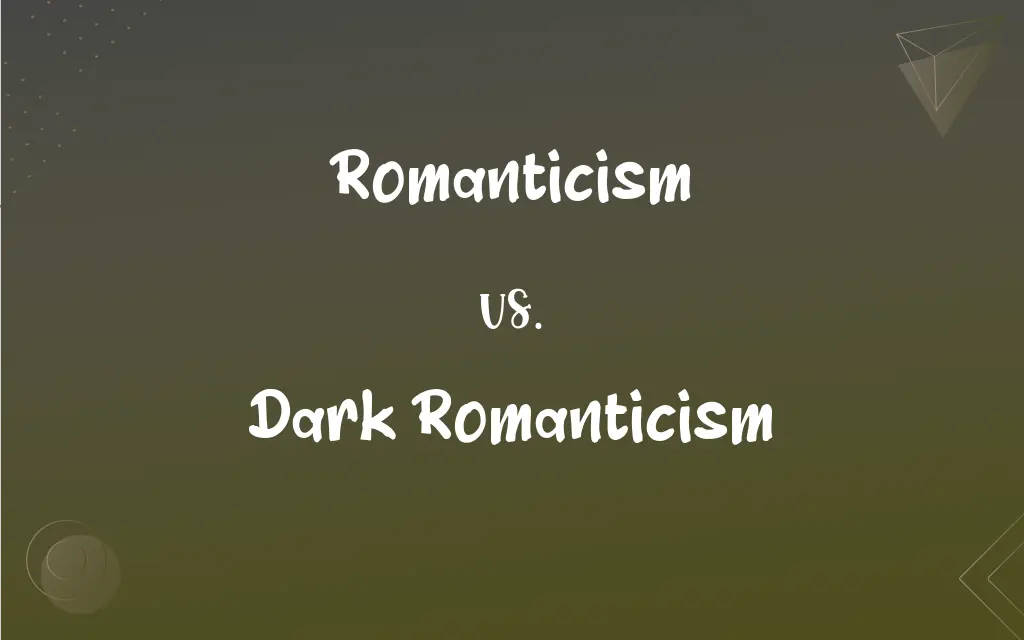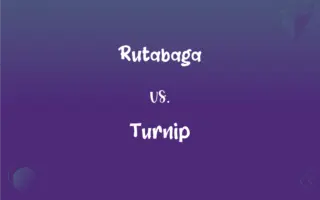Romanticism vs. Dark Romanticism: What's the Difference?
Edited by Aimie Carlson || By Janet White || Published on March 18, 2024
Romanticism celebrates nature, emotion, and individuality; dark romanticism explores human fallibility, sin, and the darker aspects of reality.

Key Differences
Romanticism and dark romanticism both emerged from the broader Romantic movement, yet they diverge significantly in themes and focus. Romanticism, flourishing in the late 18th and early 19th centuries, emphasized the beauty of nature, the importance of emotion over reason, and the value of individual experience. Dark romanticism, a subset of Romanticism, took these ideals further, delving into the complexities of human nature, including its darker sides like sin, evil, and the irrational depths of the human psyche.
Romanticism often portrayed an idealized vision of the world, celebrating heroism, the sublime, and the power of imagination, dark romanticism offered a counter-narrative. It focused on the grotesque, the tragic, and the morbid, suggesting that truth was found not just in beauty and goodness but also in the flawed and the macabre. This perspective highlighted the potential for despair and decay inherent in human existence.
In terms of literary and artistic expression, romanticism produced works filled with vivid imagery of natural landscapes, heroic individuals, and revolutionary ideals. In contrast, dark romanticism expressed a fascination with the supernatural, the mysterious, and the Gothic, often using these elements as metaphors for internal human conflicts and societal issues.
The protagonists of romantic works are typically characterized by their nobility, their struggle against societal constraints, and their pursuit of personal freedom. Conversely, characters in dark romantic narratives often grapple with their own moral ambiguities, inner demons, and the consequences of their actions, reflecting a more pessimistic view of humanity.
Romanticism sought to uplift and inspire through a celebration of the human spirit and the natural world, dark romanticism served as a critical exploration of the psychological and moral complexities of the human condition. Both movements, however, shared a deep skepticism of the Enlightenment's emphasis on reason and progress, turning instead to emotion, nature, and the subjective experience as sources of truth.
ADVERTISEMENT
Comparison Chart
Themes
Nature, beauty, heroism, individuality
Human fallibility, sin, darkness, the supernatural
View of Nature
Celebratory, sublime, a source of inspiration
Often ominous, reflecting human turmoil
Character Focus
Heroic individuals, the genius, the common man
Flawed characters, anti-heroes, psychological depth
Emotional Spectrum
Emphasis on awe, beauty, and love
Focus on melancholy, fear, and the grotesque
Perspective on Human Nature
Optimistic, emphasizing potential and goodness
Pessimistic, exploring moral ambiguity and evil
ADVERTISEMENT
Romanticism and Dark Romanticism Definitions
Romanticism
An artistic movement valuing emotion and nature over reason.
Romanticism found its expression in the awe-inspiring landscapes of Caspar David Friedrich.
Dark Romanticism
A literary movement exploring themes of sin, evil, and moral ambiguity.
In dark romanticism, Nathaniel Hawthorne dissected the complexities of guilt and redemption.
Romanticism
A literary genre that emphasizes individual experience and imagination.
Through romanticism, poets like Wordsworth explored the spiritual and emotional depths of the self.
Dark Romanticism
A reflection on human fallibility and the potential for despair.
Dark romanticism acknowledged the shadows within human souls through its brooding narratives.
Romanticism
An era celebrating the sublime and the majestic in the natural world.
Romanticism led artists to capture the untamed beauty of the Alps and the Rhine.
Dark Romanticism
A critique of romantic optimism through a lens of pessimism and realism.
Dark romanticism provided a counterpoint to its predecessor by delving into the darker sides of psychological experience.
Romanticism
A cultural movement that revered heroism and personal freedom.
The novels of the Romanticism era often featured protagonists defying societal norms for love or honor.
Dark Romanticism
A genre highlighting the dark aspects of human nature and the supernatural.
Dark romanticism is epitomized by Edgar Allan Poe's tales of mystery and the macabre.
Romanticism
Often Romanticism An artistic and intellectual movement originating in Europe in the late 1700s and characterized by a heightened interest in nature, emphasis on the individual's expression of emotion and imagination, departure from the attitudes and forms of classicism, and rebellion against established social rules and conventions.
Dark Romanticism
An artistic perspective focusing on the grotesque, fear, and the irrational.
Dark romanticism's fascination with the Gothic gave rise to haunted landscapes and doomed characters.
Romanticism
Romantic quality or spirit in thought, expression, or action.
Romanticism
A romantic quality, spirit or action.
Romanticism
A fondness for romantic characteristics or peculiarities; specifically, in modern literature, an aiming at romantic effects; - applied to the productions of a school of writers who sought to revive certain medi val forms and methods in opposition to the so-called classical style.
He [Lessing] may be said to have begun the revolt from pseudo-classicism in poetry, and to have been thus unconsciously the founder of romanticism.
Romanticism
Impractical romantic ideals and attitudes
Romanticism
A movement in literature and art during the late 18th and early 19th centuries that celebrated nature rather than civilization;
Romanticism valued imagination and emotion over rationality
Romanticism
An exciting and mysterious quality (as of a heroic time or adventure)
Romanticism
A philosophical viewpoint prioritizing the subjective and the irrational.
Romanticism challenged the Enlightenment's focus on rationality with its celebration of feeling and intuition.
FAQs
Who are prominent dark romanticism authors?
Edgar Allan Poe, Nathaniel Hawthorne, and Herman Melville are key figures.
Can romanticism and dark romanticism overlap in themes?
Yes, both can explore deep emotions and the human condition, though with different focuses.
Who are key figures in romanticism?
William Wordsworth, Samuel Taylor Coleridge, and John Keats are notable poets.
How did romanticism influence art?
It led to a focus on dramatic landscapes, emotional intensity, and personal expression.
What defines romanticism?
Romanticism is an artistic movement emphasizing emotion, nature, and individuality.
How do romanticism and dark romanticism differ in their view of nature?
Romanticism views nature as sublime and inspirational; dark romanticism often sees it as reflecting human turmoil.
What are typical themes of romanticism?
Themes include nature, heroism, individuality, and the power of emotion.
Did dark romanticism reject romanticism's ideals?
It critiqued and expanded on them, exploring the darker sides of those ideals.
What emotional tones distinguish romanticism?
Awe, beauty, and optimism are prevalent tones.
What is dark romanticism?
Dark romanticism is a subgenre focusing on human fallibility, sin, and darker themes.
What impact did dark romanticism have on literature?
It introduced complex characters, psychological depth, and Gothic elements.
Why are romanticism and dark romanticism important today?
They provide insight into human emotion, nature, and the complexities of the human condition, influencing modern thought and art.
How do romanticism and dark romanticism view the individual?
Romanticism celebrates the individual's potential, while dark romanticism examines the individual's moral and psychological complexities.
What subjects does dark romanticism explore?
It delves into sin, evil, psychological depth, and the supernatural.
How do these movements relate to the Enlightenment?
Both romanticism and dark romanticism reacted against the Enlightenment's rationalism.
Is romanticism only a literary movement?
No, it encompassed art, music, and philosophy as well.
What emotional tones characterize dark romanticism?
Melancholy, fear, and a focus on the grotesque are dominant.
What role does imagination play in romanticism?
It's central, allowing for a deeper exploration of emotion and nature.
Can a work of art or literature be both romantic and dark romantic?
Yes, some works blend both movements' characteristics, exploring a range of themes and emotions.
How does dark romanticism handle the supernatural?
It often uses supernatural elements to explore complex psychological and moral themes.
About Author
Written by
Janet WhiteJanet White has been an esteemed writer and blogger for Difference Wiki. Holding a Master's degree in Science and Medical Journalism from the prestigious Boston University, she has consistently demonstrated her expertise and passion for her field. When she's not immersed in her work, Janet relishes her time exercising, delving into a good book, and cherishing moments with friends and family.
Edited by
Aimie CarlsonAimie Carlson, holding a master's degree in English literature, is a fervent English language enthusiast. She lends her writing talents to Difference Wiki, a prominent website that specializes in comparisons, offering readers insightful analyses that both captivate and inform.































































